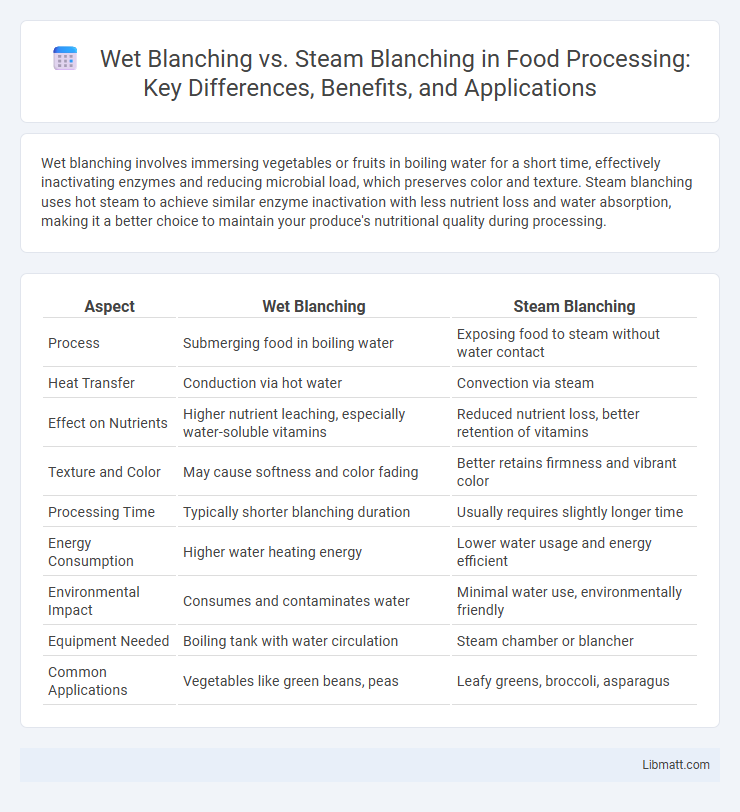Wet blanching involves immersing vegetables or fruits in boiling water for a short time, effectively inactivating enzymes and reducing microbial load, which preserves color and texture. Steam blanching uses hot steam to achieve similar enzyme inactivation with less nutrient loss and water absorption, making it a better choice to maintain your produce's nutritional quality during processing.
Table of Comparison
| Aspect | Wet Blanching | Steam Blanching |
|---|---|---|
| Process | Submerging food in boiling water | Exposing food to steam without water contact |
| Heat Transfer | Conduction via hot water | Convection via steam |
| Effect on Nutrients | Higher nutrient leaching, especially water-soluble vitamins | Reduced nutrient loss, better retention of vitamins |
| Texture and Color | May cause softness and color fading | Better retains firmness and vibrant color |
| Processing Time | Typically shorter blanching duration | Usually requires slightly longer time |
| Energy Consumption | Higher water heating energy | Lower water usage and energy efficient |
| Environmental Impact | Consumes and contaminates water | Minimal water use, environmentally friendly |
| Equipment Needed | Boiling tank with water circulation | Steam chamber or blancher |
| Common Applications | Vegetables like green beans, peas | Leafy greens, broccoli, asparagus |
Introduction to Blanching Methods
Wet blanching involves immersing vegetables or fruits in hot water for a short period to inactivate enzymes, preserve color, and improve texture, whereas steam blanching exposes produce to steam heat without direct water contact. Wet blanching is commonly used for leafy greens and small vegetables, offering uniform heat transfer but can lead to nutrient leaching. Steam blanching is preferred for products sensitive to water exposure, reducing nutrient loss and minimizing water usage in industrial food processing.
What is Wet Blanching?
Wet blanching is a food processing method where vegetables or fruits are briefly immersed in boiling water to inactivate enzymes that cause spoilage and preserve color, texture, and nutritional value. This technique helps reduce microbial load and prepares produce for freezing or further processing. Compared to steam blanching, wet blanching provides uniform heat transfer but may result in slight nutrient leaching into the water.
What is Steam Blanching?
Steam blanching is a food processing method that uses steam to heat and partially cook vegetables, preserving their color, texture, and nutrients more effectively than wet blanching, which involves submerging produce in boiling water. This technique minimizes nutrient leaching, particularly water-soluble vitamins like vitamin C and B-complex, ensuring higher retention of your food's nutritional quality. The rapid heat transfer in steam blanching makes it an energy-efficient option that also reduces waste of cooking water compared to wet blanching.
Key Differences Between Wet and Steam Blanching
Wet blanching involves immersing vegetables in boiling water, resulting in rapid heat transfer and uniform cooking, while steam blanching exposes produce to hot steam, reducing nutrient loss and water absorption. Wet blanching often causes leaching of water-soluble vitamins such as vitamin C and B-complex, whereas steam blanching better preserves these nutrients and maintains texture by minimizing contact with water. Steam blanching also reduces environmental impact by lowering wastewater generation compared to wet blanching, which produces nutrient-rich effluents requiring treatment.
Nutrient Retention: Wet vs Steam Blanching
Wet blanching preserves water-soluble vitamins such as vitamin C and B-complex more effectively due to shorter exposure to heat compared to steam blanching. Steam blanching reduces nutrient leaching since food is not immersed in water, resulting in better retention of minerals like potassium and magnesium. Studies show steam blanching maintains antioxidant compounds more efficiently, enhancing overall nutrient preservation in vegetables.
Impact on Food Texture and Color
Wet blanching preserves vibrant color by rapidly inactivating enzymes but may lead to softer texture due to water absorption. Steam blanching maintains firmer texture by minimizing moisture contact, helping retain natural crispness and structure. Your choice between the two methods directly influences the visual appeal and mouthfeel of the final product.
Energy Efficiency Comparison
Wet blanching typically consumes more water and energy due to prolonged heating and cooling cycles, whereas steam blanching offers higher energy efficiency by using direct steam contact, reducing heat loss and processing time. Steam blanching requires less water, minimizing energy needed for heating and wastewater treatment, making it a more sustainable option for industrial-scale operations. Choosing steam blanching can optimize your energy consumption and lower operational costs in food processing.
Suitability for Different Foods
Wet blanching is ideal for vegetables with high water content like spinach, beans, and peas as it effectively halts enzymatic activity and preserves color and texture. Steam blanching suits dense or delicate foods such as broccoli, cauliflower, and mushrooms, minimizing nutrient loss and surface water absorption. Choosing the right blanching method enhances Your food's quality and shelf life, depending on the food's texture and moisture level.
Environmental Considerations
Wet blanching consumes significantly more water and generates wastewater that requires treatment before disposal, impacting aquatic ecosystems. Steam blanching uses less water, reducing water consumption and lowering the volume of wastewater produced, making it more environmentally sustainable. Energy usage in steam blanching can be optimized with heat recovery systems, further minimizing its environmental footprint.
Choosing the Right Blanching Method
Choosing the right blanching method depends on the type of food and desired quality outcomes. Wet blanching involves immersing vegetables in boiling water, offering efficient heat transfer and enzyme inactivation, ideal for leafy greens and root crops. Steam blanching preserves more nutrients and color by using direct steam, making it suitable for delicate vegetables and fruits, ensuring Your final product maintains optimal texture and flavor.
wet blanching vs steam blanching Infographic

 libmatt.com
libmatt.com